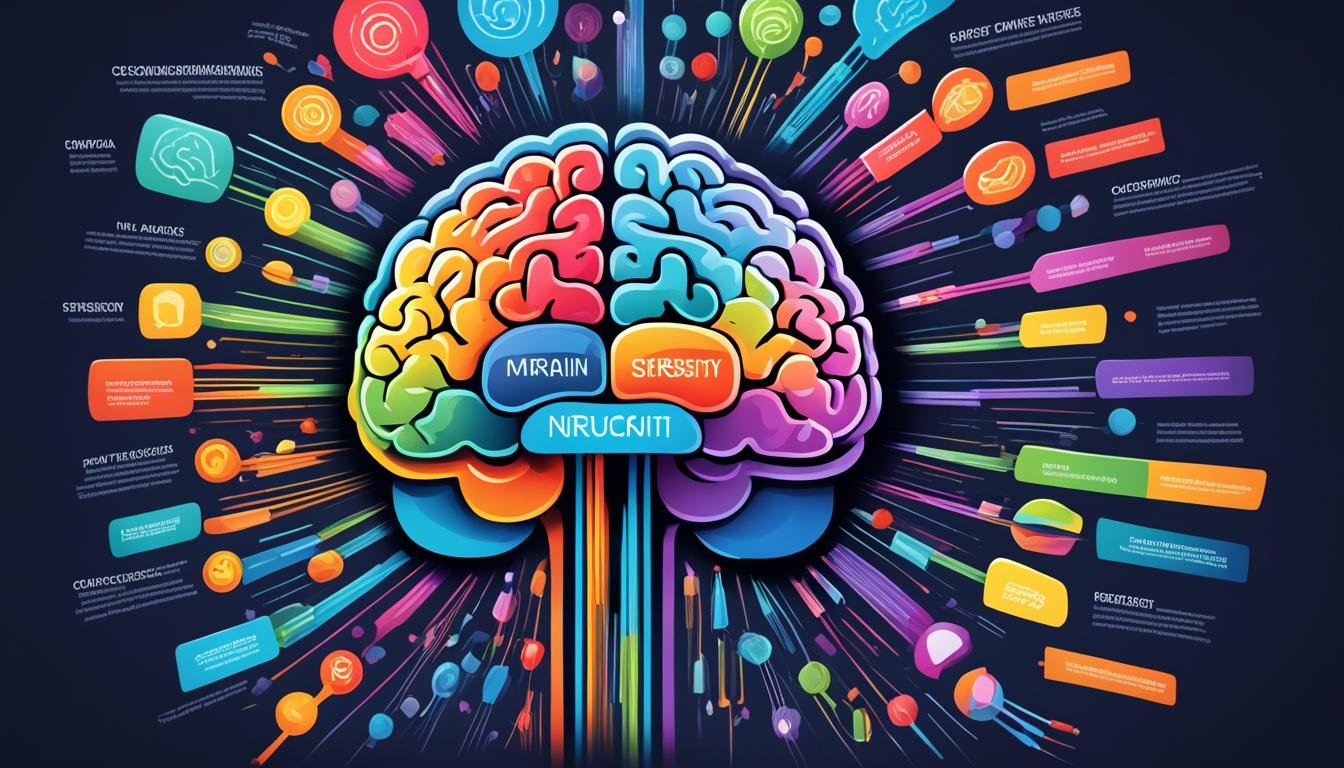Neuromarketing: Understanding the Brain of the Consumer
Did you know that neuromarketing combines neuroscience and marketing to cut down on misunderstandings between brands and consumers? It uses brain activity to figure out what really connects with people. This approach has changed how brands talk to their customers in the last five years.
Even Nobel Prize winner Francis Crick believed our thoughts, feelings, and choices come from our brain. This idea is key to understanding consumer behavior. It shows how deep neuromarketing goes into the science of what makes us buy things.
Key Takeaways
- Neuromarketing uses neuroscience to get into consumer behavior and improve marketing.
- Methods like fMRI and EEG show how our brains react to ads.
- Eye tracking and biometrics help make ads better by seeing how people react.
- Neuromarketing gives a full picture of what consumers think and feel, even if they don’t realize it.
- It offers deep insights but also raises questions about privacy and if it’s right to influence our choices.
What is Neuromarketing?
Neuromarketing uses neuroscience to study how our brains react to marketing. It’s a mix of science and marketing that helps us understand what makes consumers tick. This method looks at how our brains respond to ads and products in ways traditional methods can’t.
Introduction to Neuromarketing
Neuromarketing combines neuroscience with marketing to predict and shape consumer behavior. Recent studies show its power in understanding how people react to ads. It uses brain scans and other tools to see how our brains respond to marketing.
The Science Behind Neuromarketing
At its heart, neuromarketing is a scientific field. It believes our feelings, thoughts, and actions come from our brain’s neural activity. Tools like fMRI and EEG measure our emotional reactions and where we focus our attention. Biometrics track our heart rate and skin temperature to see how we feel.
Specialists warn that some vendors may oversell what neuromarketing can deliver, emphasizing the importance of rigorous scientific methodology and peer-reviewed studies to validate the insights provided by these methods.
The neuromarketing market is growing fast—it was worth almost $3.3 billion in 2023. Marketers need to be careful with these methods and their claims. By really understanding how our brains work, brands can make ads that grab our attention and work better.
Techniques and Tools in Neuromarketing
Neuromarketing uses advanced tools and techniques to explore consumer minds deeply. It uses brain imaging and neuroimaging to understand how people react and feel. This field offers many ways to study consumer behavior, giving marketers deep insights.
fMRI and EEG
Functional Magnetic Resonance Imaging (fMRI) and Electroencephalography (EEG) are key in neuromarketing. fMRI shows detailed brain activity, helping researchers see which brain areas react to different things. It’s very accurate but expensive and not easy to move around.
EEG, on the other hand, measures brain electrical activity quickly. It helps understand how people think and react right away. It’s cheaper and easier to use than fMRI. Using EEG with eye-tracking gives even more insights.
Eye Tracking and Pupillometry
Eye tracking is a common tool in neuromarketing. It tracks where people look and how interested they are. It looks at how long someone focuses on something and how often they look at it. There are different types of eye tracking, each with its own benefits.
Pupillometry measures how wide the pupils get, showing how emotionally engaged someone is. These tools together help understand what grabs people’s attention and how they see different things.
Biometrics and Facial Coding
Biometrics and facial coding measure physical and emotional reactions. Biometrics tracks heart rate, skin conductance, and muscle activity. This shows how stressed, excited, or emotional someone is.
Facial coding looks at facial expressions to figure out emotions. But, it’s being replaced by more reliable methods at companies like Nielsen and Microsoft. Still, these methods give a full picture of how emotionally engaged consumers are.
Applications of Neuromarketing in Modern Advertising
Neuromarketing is changing how we advertise by looking into what we think without us realizing it. It uses tools like fMRI, EEG, and eye-tracking to understand what we like. This new approach gives brands clear insights to make ads that grab our attention and work better.
We’ll look at how neuromarketing helps in advertising, focusing on color psychology, packaging, and fighting decision fatigue.
Color Psychology
Color psychology is a big part of emotional marketing. Colors make us feel certain ways, which is why they’re so important in ads. Studies show that the right colors can make a product more appealing and increase the chance of us buying it.
For instance, warm colors like red and yellow make us feel excited and ready to act fast, which can lead to more sales.
Effective Packaging
Getting our attention is tough in a crowded market. That’s where sensory marketing comes in, focusing on what we touch and see. By using neuromarketing, companies can make their packaging stand out and connect with us on a deeper level.
This approach helps products be more noticeable and builds loyalty. Sadly, over half of new products don’t make it, but neuromarketing can help match products with what consumers want.
Decision Fatigue and Efficiency
With so many choices, making decisions can be hard. Neuromarketing helps brands make shopping easier. For example, eye-tracking shows how to make websites better for users.
This helps brands make ads and websites that are easier to use, leading to more sales and happier customers. Personalized marketing based on what we naturally react to makes ads feel more natural and satisfying.
Neuromarketing: Understanding the Brain of the Consumer
Neuromarketing offers deep insights into how our brains make choices. It helps companies create ads that really speak to us. By using behavioral economics, they can guess and shape what we buy.
This field uses tools like fMRI and EEG to see how our brains react to ads. EEG’s ability to track brain activity shows us emotions in real time. This info is key to understanding how ads affect us.
Facial coding and eye-tracking help us see what ads make us feel. They track our eye movements and facial expressions. This helps companies make ads that grab our attention better.
Heart rate monitors and GSR measure our emotional responses to ads. Brands use this info to make their ads more appealing. This way, they connect better with what we like.
Did you know 95% of our choices are made without us even thinking about it? Neuromarketing helps spot and use these hidden thoughts. This makes ads more effective and persuasive.
Henri Tajfel, a social psychologist, believed that the minimal group paradigm highlighted how being in a group changes our behavior. This shows how important behavioral economics is in neuromarketing.
Neuromarketing helps us understand more than just what we like. For example, Frito-Lay changed their packaging to avoid negative reactions. IKEA designed their stores to make shopping better and increase sales.
But, there are ethical concerns too. Political parties using neuromarketing faced criticism. Brands need to be careful and have plans for when things go wrong.
- Tools used in neuromarketing: EEG, fMRI, facial coding, eye tracking, and GSR.
- 95% of decision-making is estimated to be unconscious, highlighting the significance of neuromarketing.
- Real-world applications: Frito-Lay’s packaging redesign and IKEA’s store layout.
Neuromarketing and Consumer Behavior
Understanding how people act is key to making marketing work. Neuromarketing looks into the hidden mind to see real reactions to ads. It uses predictive analytics to guess what people like and improve ads. This makes marketing stronger and gets people more involved.
Predicting Consumer Choices
Neuromarketing aims to guess what people will choose. It uses tech like fMRI, EEG, and eye tracking to read brain signals. For example, a study showed that hungry people were more likely to buy on impulse. This shows the brain’s reward areas were active.
Neuromarketing helps in identifying effective advertising by analyzing consumer responses to different ads and improving product designs.
Influencing Decision Making
Neuromarketing can change how people make choices. By knowing how the brain reacts to ads, companies can make ads that trigger certain feelings. For example, they can use facial expressions and biometric data to make ads more exciting or trustworthy.
Also, neuromarketing uses eye tracking and A/B testing to see what grabs attention. This mix of understanding people and using data makes marketing more effective. It leads to better results for businesses.
Ethical Considerations in Neuromarketing
Neuromarketing is growing, and so are the ethical concerns. At the heart, we worry about how it affects consumer privacy and if it could be used to manipulate people. Techniques like fMRI and EEG help us understand what consumers think and feel. But, this raises big ethical questions, especially since rules and standards are still weak.
Privacy Concerns
Privacy is a big worry in neuromarketing. These methods collect data fast, but that comes with risks. Companies must protect this data and keep participants’ info safe. If they don’t, it could harm trust and lead to bad marketing practices.
Some have criticized these efforts for not being transparent. They worry about how they might affect our choices and freedoms.
Potential for Manipulation
There’s also a fear of being manipulated by neuromarketing. It can peek into our minds, which makes some uneasy. It’s a thin line between guiding choices and controlling them. Critics say this could break trust and trick people.
So, we need a strong ethical approach to avoid this. Brands must be clear and honest to keep a good relationship with consumers.
Case Studies and Success Stories
Neuromarketing has changed the way brands advertise, giving them deep insights into what consumers like. Studies and success stories show how neuromarketing has made a big impact in the market.
Notable Studies
A key study by Montague from The Baylor College of Medicine used fMRI scans on 67 people. They tested Pepsi and Coca Cola without labels. Most people liked Pepsi better, but when they knew the brands, they chose Coca Cola more.
This shows how feelings can affect what we choose, even if it’s not just about taste. It’s a big deal for brands to know this.
Another study by Simister and Anderson looked at pricing. They found that prices ending in 9 sell more than lower prices. This is called the left-digit effect. It shows how small changes in price can make a big difference.
Brand Success Stories
Many brands have done well by using neuromarketing. For instance, an e-commerce site got more people to buy things by changing its checkout process. This was based on neuromarketing advice.
A popular streaming service also did better by making content that matched what people liked. They used eye tracking and brain scans to figure out what to do. This way, they made messages that really spoke to their audience.
Eye tracking helps brands see where people look and what grabs their attention. This helps with website design and where to put content. Brands that focus on what customers want do better online than those that don’t.
In the end, using neuromarketing and subliminal ads helps brands do better. It shows how neuromarketing has changed advertising for the better.
The Future of Neuromarketing
The future of marketing is changing fast with new brain science. Tools like EEG, fMRI, and eye-tracking give deep insights into how we react to ads. These tools help companies predict trends and tailor their ads to what people like.
Some of the top neuromarketing trends focus on understanding emotions and hidden behaviors. For example, ads that touch our feelings do 23% better than those that don’t. This shows how important it is to connect with people on an emotional level.
Also, 85% of the time, we don’t think about our choices when buying things. This means we need to look at what’s going on in our minds without us realizing it. This is key to understanding what drives us to buy.
Google and Microsoft have shown how neuromarketing can improve product design. A Nielsen study found that knowing how emotions work in our brains can make ads more engaging and effective.
As we go forward, neuromarketing will change how companies talk to their customers. Tools like eye-tracking and facial emotion recognition help agencies see what people really think. This will lead to new marketing methods that match what people really want.
But, as neuromarketing grows, we need to think about ethics. There’s no one watching over it, so we must follow rules about consent, privacy, and data security. This keeps people safe and protects their information.
Using neuromarketing helps businesses stay ahead in a changing market. Small companies can use simple methods like testing different ads and listening to what customers say. The future of marketing is exciting, blending brain science with digital tech.
Conclusion
Neuromarketing has become key in understanding how our brains affect what we buy. By using tools like fMRI and EEG, experts can see how emotions play a big role in our choices. This shows how touching our feelings can make brands stronger and ads more effective.
Brands that make us feel good activate parts of our brain linked to happiness. Using our senses, like seeing, hearing, smelling, touching, and tasting, makes our experiences richer. This helps us make choices easier and feel better about them. It turns guessing into a science, helping businesses connect with us better.
Behavioral economics in neuromarketing gives us new insights into what drives us. But, it also makes us think about the right way to use this knowledge. We need to make sure marketing is fair and respects our choices. The future looks bright with new tech like virtual reality, augmented reality, and artificial intelligence. These will help us understand people better and make marketing more meaningful.
Source Links
- Neuromarketing: Understanding the Science Behind Consumer Decisions
- The Power of Neuromarketing: Understanding Consumer Behavior Through Brain Science
- Neuromarketing: Understanding the Consumer Brain for Successful Campaigns
- Neuromarketing: What You Need to Know
- What is Neuromarketing? Neuromarketing Techniques and Examples | The Chicago School
- What is Neuromarketing & How to Use It? | Neurons
- Neuromarketing — New Tools in Consumer Behavior Analysis
- The 7 best neuromarketing techniques and tools | Bitbrain
- The Role of Neuromarketing in Modern Advertising: Unlocking Consumer Behavior
- 25 examples of neuromarketing applications | Bitbrain
- Technological advancements and opportunities in Neuromarketing: a systematic review
- Neuromarketing: Understanding Consumer Behavior Through Neuroscience
- What is Neuromarketing?
- Neuromarketing — Predicting Consumer Behavior to Drive Purchasing Decisions – Professional & Executive Development | Harvard DCE
- Neuromarketing – Insights Into Consumer Behavior
- Consumer Behavior Vs. Neuromarketing
- The Science of Neuromarketing: Understanding Consumer Behavior for Smarter Campaigns
- An overview of ethical issues in neuromarketing
- Neuromarketing and consumer neuroscience: contributions to neurology
- Learn Neuromarketing- Tips, Examples & Case Studies
- Unlocking Consumer Behavior: The Power of Neuromarketing in Digital Media » iQWeb Solutions
- Council Post: Neuromarketing: The Future Of Marketing Strategy
- The Future of Neuromarketing : Shape The Market
- The Future of Marketing: Predicting Trends and Innovations in Neuromarketing
- Neuromarketing: Understanding Consumer Decision-Making Processes
- Decoding the Consumer Brain: The Science and Ethics of Neuromarketing







